Penglipuran Village is Bali‘s most famous “traditional village”, renowned for its pristine beauty and steadfast preservation of traditional Balinese customs. It is also a place where the community has graciously opened its doors to the public to help promote and celebrate Balinese culture. Often described as the cleanest village in the world, it strongly adheres to the Balinese philosophy, promoting harmony between humans, nature, and the divine. To help you plan your visit and get the most out of your time here, we put together this travel guide for visiting Bali’s Penglipuran Village. If you have some extra time, be sure to explore the scenic bamboo forest trail next to the village.
Disclosure: This page (Bali’s Penglipuran Village – A Visiting Guide) may contain product affiliate links. At no additional cost to you, we may receive a commission for purchases made through these links. More details can be found on our disclosure and policies page.
Planning a Trip to Bali?
You might be interested in these pages:
Best Things to See and Do in Ubud
Best Things to See and Do in Gili T
The Perfect Three-Week Bali Itinerary
Best Things to See and Do in East Bali
We also highly recommend these travel guidebooks:
Lonely Planet Bali, Lombok & Nusa Tenggara
Bali: The Solo Girl’s Travel Guide
Rough Guides: Bali and Lombok








Penglipuran Village: Location & Map
Penglipuran Village is located in Bali’s Bangli regency (link to Google Maps), northeast of Ubud and near the Goa Raja and Tukad Cepung waterfalls, as well as Pura Kehen. There is a fairly large parking lot next to the ticket office.

How to get to Penglipuran Village
Drive times can be highly variable depending on the traffic conditions.
Distance from Ubud: 30 km // Average Drive Time: 50 – 65 min
Distance from Kuta: 55 km // Average Drive Time: 1h45 – 2h
Distance from Canggu: 55 km // Average Drive Time: 2h – 2h15
Distance from Sanur: 40 km // Average Drive Time: 1h30 – 1h45
Distance from Sidemen: 30 km // Average Drive Time 1h-1h15
In our opinion, the three best transport options to reach Penglipuran Village are: renting a scooter (moped), joining a group tour that hits several nearby attractions within a day or a half-day, or hiring a car and driver (which really isn’t as expensive as it sounds).
You can also use Bali ride-hailing apps such as Gojek or Grab, and make use of local taxis, but these options will typically cost more, especially if you plan on visiting several sites and attractions on the same day. Also, Gojek or Grab are not authorized to pick up people in certain locations where local taxi unions limit their services, including Canggu, Sanur, and Ubud. For more information on getting around the island and the different available options, check out our guide on How to Best Get Around Bali.
We highly recommend Airalo (eSIM card) for your connectivity needs when travelling abroad. Airalo is the world’s first and largest eSIM store with eSIM plans for 200+ countries and regions worldwide.
Getting to Penglipuran Village by Scooter: Once you get to Bali, you’ll quickly realize that scooter rental operators are everywhere. Although most street-side vendors will regularly be the cheapest option, they come short in several other aspects compared with more reliable and established vendors. For instance, most won’t offer roadside assistance or insurance that covers theft, nor do they regularly sanitize the helmets or have their scooters undergo regular maintenance. For this reason, we highly recommend using Bikago for your scooter rentals. Renting from them might be slightly more expensive (but still can be rented for as low as 12-15 US$/€ per day) but you get great peace of mind as among many other perks, all scooters undergo extensive quality checks.
What you get with your Bikago rental:
-Helmets
-Full tank of petrol and unlimited mileage
-Free Delivery and Collection at your Hotel
-24/7 Roadside Assistance and First Aid Medical Kit
-Charging Mobile Phone Holder
By Car and Driver hire: Hiring a car and driver to explore Bali can be a practical and cost-efficient way to experience a full day of sightseeing. Although this option is more expensive than renting a scooter (typically 40-60 US$/€ per day), you don’t have to worry about navigating the Bali roads and traffic. Also, most cars are modern and air-conditioned, which is welcome in Bali’s humid heat, and the local drivers always know the best routes to take and can optimize your ideal itinerary. Here are some of the best options to choose from:
By Group Tour: Group tours can be a great option to lower costs and reduce the hassle of having to plan an efficient itinerary. Their main downside is they might not exactly be tailored to your specific interests and preferences. But if you are mostly interested in hitting the main sights and attractions, there are these great tour options that can pick you up in multiple towns and visit places including Penglipuran Village:
Penglipuran Village – Ticket Price and Operating Hours
Entrance Fee
The Penglipuran Village entrance fee is 50,000 IDR per person (2025), which roughly amounts to 3.00 US$/€.
Modest additional costs are required for parking: 2,000 IDR for scooters and 5,000 IDR for cars.
Having the exact change or small bills to pay for all costs is preferable as many temple sites don’t accept credit cards and they may not have enough change for large bills. To our knowledge, there are no ATMs in the immediate vicinity of Penglipuran Village.
Opening Hours
Penglipuran Village is open daily from 8 am to 6h30 pm.
Facilities
Clean and modern toilets are available next to the car park and ticket office.
Dress Code
As with most Balinese historic sites, it’s important to dress modestly and to ensure your shoulders and knees are covered. However, wearing a sarong is not required to visit the village.
About Penglipuran Village and its History
Penglipuran is one of several traditional Balinese villages (kampung) in Bali – though it is its most popular among tourists. (more on the bamboo forest further below). Research indicates that Penglipuran Village’s history dates back to the era of the Bangli Kingdom, approximately 700 years ago. Today Penglipuran Village has a population of about 1000 inhabitants.
What makes Penglipuran unique and appealing to visitors is that it succeeded in building tourism that benefited all of its community without losing its culture and traditions. The organization of the village and the architecture within it follows the concept of Tri Hita Karana, the Balinese philosophy promoting harmony between humans, nature, and the divine. Tri Hita Karana translates to the “three causes of well-being”.





The Balinese government started promoting Penglipuran as a tourist destination in 1993. Trying to avoid tourism capitalism in Penglipuran, the village residents wanted to develop a “community-based-tourism”. Within this approach no individual benefits directly from tourism: any income generated by tourism funds developments in the village. Village tour guides, ticket officers and other employees are directly employed by the village and get paid from the amount of profit earned.
In 1995, Penglipuran also received a Kalpataru award from the Indonesian government for its efforts to protect the bamboo forest in their local ecosystem. The Indonesian government has also hailed the village as the best tourism village in the country, and Penglipuran received a United Nations World Tourism Organization (UNWTO) award in 2023 as one of the Best Tourism Villages in the world.
Penglipuran Village – What to Expect
Although the village itself is not particularly large, composed mostly of a single main street with a few smaller side streets offshooting from it, there’s still a lot to see here. You could probably see the entire village quickly in 15 minutes, but you would be missing out on a lot of what the village has to offer.





Penglipuran’s main street is one of the most photogenic streets we’ve ever come across. For starters, it’s for pedestrians only – no cars allowed. It’s also very clean – indeed Penglipuran has the reputation of being one of the cleanest villages in the world (it also has a ban on single-use plastics that helps keep the village spotless). The traditional architecture is also simply beautiful, where each home is decorated with intricately carved gates.






Once you’ve wandered up and down the main street, it’s time to check out some of Penglipuran’s 77 traditional homes, many of which leave their gates open and invite visitors to explore the inner courtyards.









Several villagers have also turned their homes into small gift shops, where you can purchase among other things bamboo crafts, woven baskets, and specialty carvings.



At the northern of the main street lies Penataran Temple, the village’s main temple. We were fortunate to witness the end of a ceremony during our visit, where the locals leaving the temple walked down the main street wearing their traditional ceremonial outfits.




Penglipuran’s Bamboo Forest
Beyond the northern end of the village, lies a stunning and little-known bamboo forest. So few visitors make their way to the forest (we almost had the forest to ourselves during our visit) – and that’s a shame, as it’s not only beautiful but it’s also the perfect escape from the Bali heat.





The Penglipuran Bamboo Forest is considered to be one of the most significant intact bamboo forests in Bali, both because of the quality of the bamboo as a construction material and of the significance that it holds. and therefore serves as a powerful symbol of their cultural roots. The bamboo forest here is farmed rather than naturally occurring (villagers believe that the forest was initially planted by their distant ancestors). The forest is entirely managed by the villagers, some of whom have the right to exploit the bamboo commercially.
To reach the forest, simply follow the village’s main street toward the Pura Penataran temple (uphill direction), which will swerve to the left of the temple and continue north. Once you pass the temple, you reach the bamboo forest in about 2 minutes.
Although not particularly long, the path through the bamboo forest is quite scenic and it leads to a cozy outdoor café (Cafe Kebun – link to Google Maps).



Other Visiting Tips and Activities
– Photo ops: Some village locals rent Balinese outfits for photoshoots (typically around IDR 50,000 – 75,000). They will even help you put on the outfits and show some great photo spots.
– Enjoy a home-cooked meal: If you visit around lunchtime, several local families prepare and sell authentic Balinese dishes (various prices – but typically not very expensive).
– Bring cash: Most transactions, including entrance fees, gift shop items, and meals, are cash-only.
– Respect ceremonies: Observe rituals from a distance and avoid intrusive photography. Always ask permission before photographing locals, especially during ceremonies.
– Watch your step: Look out for canang sari (small offerings) on the ground, they tend to be positioned in front of house gates.
– Mobility and accessibility: The village’s car-free paths make it wheelchair- and stroller-friendly. However, assistance may be needed to enter some of the traditional homes with steps.
How Long Do You Need at Penglipuran Village
We recommend planning to spend about an hour in Penglipuran Village, especially if you want to spend some time walking through the bamboo forest.
Best Time to Visit Penglipuran Village
Best Time of the Year
Although we visited during the dry season, there’s no bad time of year to visit the temple. There’s a higher risk of rain during the wet season (November-April), but that shouldn’t discourage you as there are likely to be fewer other tourists around.
Consider off-peak months like May-June or September-October for a more personal experience with fewer crowds.
Best Time of Day
The best time to visit is definitely in the early morning when it’s cooler and when there a far fewer other tourists around. You will be able to visit the village in a much more relaxed atmosphere. Arriving early is particularly important on weekends as the village is a favorite attraction among the Balinese as well.
If you can’t make it early in the day, try the late afternoon, an hour or two before closing time. It will likely still be quite warm, but the amount of visitors will have started to thin down.
Sights and Attractions near Penglipuran Village
The closest attractions to the village are located slightly east of it and include the small hidden gem Pura Kehen and three fantastic waterfalls: Tukad Cepung, Yeh Bulan, and Goa Raja.





A short drive west of the Penglipuran is a cluster of four temples: Gunung Kawi Tampaksiring, Pura Mengening (another hidden gem), Tirta Empul and Pura Gunung Kawi Sebatu.





To discover more of Bali’s temples, be sure to check out our guide on Bali’s Best Temples to Visit.
For a more complete list of attractions that you can visit from Ubud, check out our guide on the Best Day Trips from Ubud.
Where to Stay Near Penglipuran Village
In our opinion, the best place to stay in the area is in Sidemen, whose location makes it a great base from which to explore East Bali’s waterfalls and temples. These are two of the best mid-range hotel accommodations that are set in a beautiful location amongst the rice fields.:
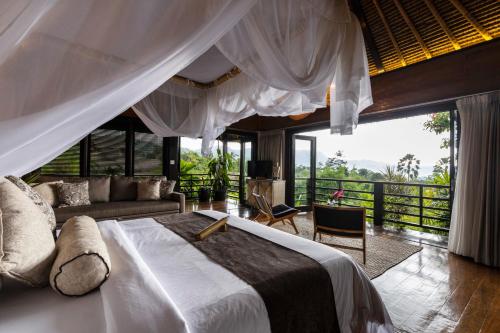
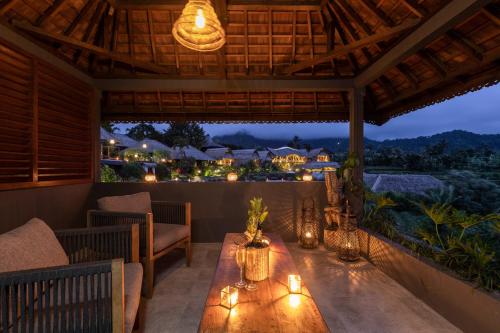
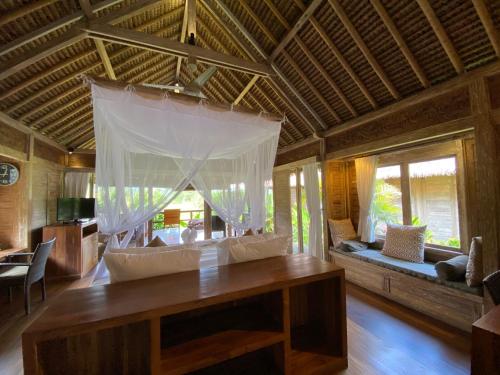

If you are looking to splurge, Wapa di Ume Sidemen is simply fantastic and is located on the same street as the other two accommodation options above:


Another great base in Bali is Ubud. It’s a bit further from Pura Kehen, but it’s well-located to visit several other fantastic attractions throughout Bali. All of the following are some of the best mid-range hotel accommodations located within walking distance from the city center:
Komaneka at Rasa Sayang Ubud Hotel



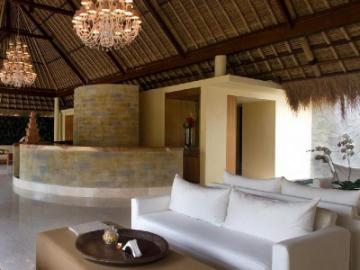

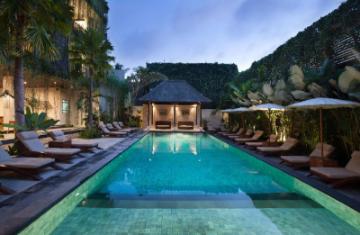

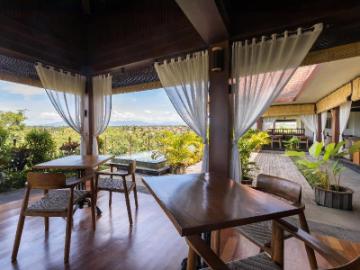


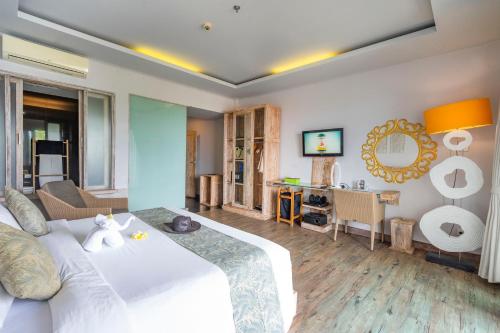





Planning a Trip to Bali?
You might be interested in these pages:
Best Things to See and Do in Ubud
Best Things to See and Do in Gili T
The Perfect Three-Week Bali Itinerary
Best Things to See and Do in East Bali
We also highly recommend these travel guidebooks:
Lonely Planet Bali, Lombok & Nusa Tenggara
Bali: The Solo Girl’s Travel Guide
Rough Guides: Bali and Lombok
Photography Gear
If you like our photography, you might be interested in some of the gear we use to shoot our travel and hiking destinations.
Camera Body – Nikon Z 6ii Fx-series Mirrorless Body
Main Lens – NIKON 24-120mm F/4G ED VR AF-S
Zoom Lens – Sigma 745-306 150-600mm f/5-6.3
Polarizing filters – Urth Circular Polarizing (CPL)
Camera Tripod – K&F Concept 64-inch Camera Tripod
Mini-tripod – Lammcou Flexible Camera Tripod
Camera/hiking backpack – Vanguard Alta Rise 48 Backpack
Universal Travel Adapter – VYLEE Universal International Power Travel Plug
Other Travel Essentials
Travel Insurance
SafetyWing is a travel insurance company that offers comprehensive coverage for travellers. Includes Medical Insurance and Travel Insurance. Primarily geared towards long-term travellers, digital nomads, and expats.
e-Sim cards
Airalo is the world’s first and largest eSIM store with eSIM plans for 200+ countries and regions worldwide. With Airalo eSIMs, travellers can get connected the moment they land at their destination and avoid nasty data roaming charges
eSIMS are a sustainable alternative to single-use SIM cards – they are 100% digital, require less energy to produce and be re-used rather than disposed of.
Car Rentals
Discover Cars is our go-to website for car rentals. We almost always find our preferred rate there.
Transfer from Airport
Welcome Pickups is our favourite private transfer service, which you can pre-book at a fixed price. Currently available in 220 cities all over the world (mostly in Europe, but with several major cities in Asia, the Middle East and the US).
Kiwitaxi is another private transfer service – we haven’t tried it yet, but it’s currently available in a few more countries (102 as of 2024).
Hotels and Accommodations (coming soon)
Photography Prints
If you found this blog useful, you can help support our blog by purchasing low-cost digital prints. Printed physical prints are also available for purchase.








—–
Well, that wraps it up! We hope you enjoyed our travel guide on Bali’s Penglipuran Village and that it will prove useful for planning your trip.
—–
You might also be interested in these related pages:

























